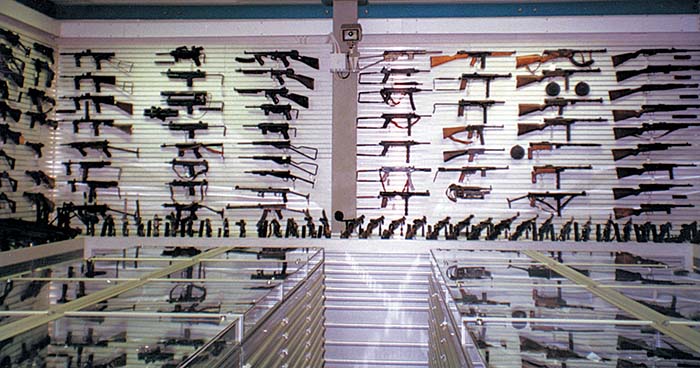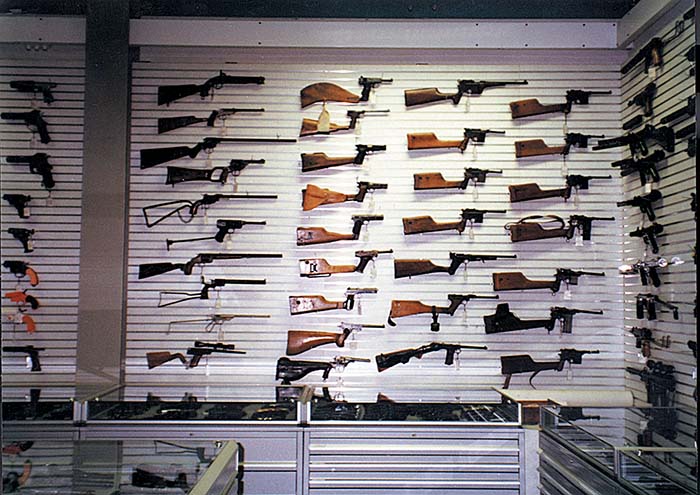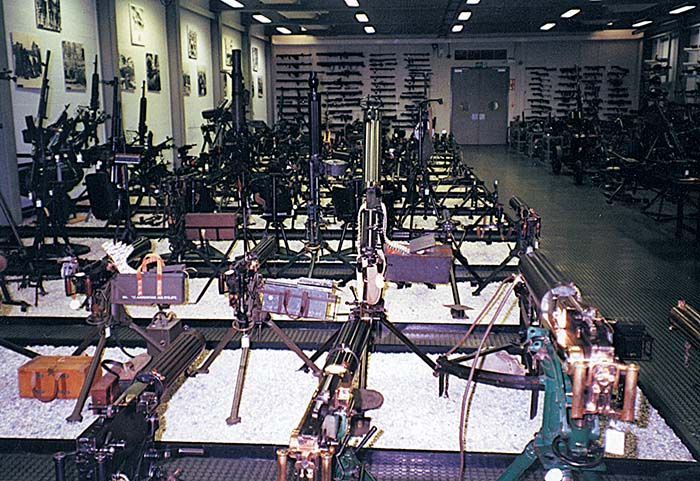By Virginia Ezell, Photos by Richard Anderson
Are Rumors of the death of the Pattern Room Greatly Exaggerated?
The fate of the British Ministry of Defence (MOD) Pattern Room hangs in the budget balance these days. While it’s fate is still uncertain, pessimists in the United Kingdom already are ringing the death knell for the institution which will be celebrating its 367th anniversary this year.
Begun during the reign of Charles I out of the king’s frustration with the vagaries in small arms manufacturing, the Pattern Room served to standardize and improve design of infantry weapons. All sealed patterns of weapons were housed first at the Tower of London. A wax seal on a sample weapon was the royal sign of approval for that pattern. The sealed pattern represented the standard reference for that particular weapon. It was the monarch’s way of ensuring some level of consistency in firearms manufacturing well before the age of mass production.

Over the centuries the Pattern Room’s mission changed to meet the demands of it’s masters, from king to parliament. A major increase in the collection’s influence in small arms manufacturing in Britain came with the introduction of the American system of manufacturing during the middle of the 19th century. The Pattern Room already had been co-located at the Royal Small Arms Factory at Enfield, in the outskirts of London. About the time the factory introduced the concept of mass production of interchangeable parts, the Pattern Room fell under the direction of the Chief Inspector of Small Arms, responsible for weapons acceptance. Similar to their American counterparts at the Springfield Armory in Massachusetts, weapons inspectors used standard gauges based on sealed patterns from the Pattern Room to verify the quality of weapons coming off the production line. Over time that role changed as production standardization increasingly depended on design drawings in the manufacturing process. With that change came a shift in the Pattern Room’s influence over the design process. The collection of firearms specimens evolved to represent a reference library of materials and documents British arms design engineers turned to for ideas.

Today there are over 11,300 objects in the holdings at Nottingham. Of those, about 8,500 are weapons ranging from automatic pistols to recoilless rifles. They have military firearms dating from the 1800s to the present; everything from machine-guns to anti-aircraft guns. The Pattern Room’s library contains books and manuals for weapons and ammunition from around the world. They also have historical ordnance and procurement records. As a result the Pattern Room is viewed as a primary source of information for weapons designers and historians around the world.
After their resounding victory at the end of the Cold War, some representatives within western governments smelled a peace dividend in the winds of change sweeping across Europe. The resulting higher threat threshold has been accompanied by significant declines in defense budgets. Continuing along the path of its Conservative predecessors, the current Labour government wants to cut defense costs further. Part of that has included a review of the relevance of the Pattern Room in meeting peacekeeping requirements of a new age army in the new world order. As an asset of the Ministry of Defence, the Pattern Room’s collection is funded through the MOD’s Procurement Executive.
The Pattern Room costs the British tax payer approximately £200,000 (US$326,000) each year. That keeps the lights on, pays the rent to Royal Ordnance for use of the secure building within the company’s compound in Nottingham, and buys weapons, books and documents to add to the collection. It pays the salaries of the staff who escort the more than 3,000 visitors coming to the facility and respond to over 1,000 inquiries each year.

A more recent, and perhaps most dramatic, change in management took place after privatization in 1988 when the Royal Small Arms Factory became Royal Ordnance (RO), and a subsidiary of the major arms maker British Aerospace. While the manufacturing responsibilities shifted to the private sector, the Pattern Room remained within the military domain under the Master General of the Ordnance in 1989. Not long after the closing of the Royal Ordnance site in Enfield, the Pattern Room and its collection were relocated to a new building in RO’s facilities in Nottingham.
According to a Ministry of Defence spokesman, the case for the pattern room came under scrutiny at that point. Its primary function as a reference collection of weapons and weapons design documentation had been taken over by events. In November 1997, during “question time” in parliament the current government was asked what its plans were regarding the Pattern Room. The MOD’s response was that there were no plans at that time, since they were in the process of a management review.
While various reorganizations took place over the years, the Pattern Room’s primary mission to support the MOD’s weapons procurement activities saw few changes. During hot wars, designers at the Royal Small Arms factory looked to the collection to view earlier designs. Just as books in a library, the weapons in the Pattern Room represented the recorded knowledge of the past to guide designers away from their predecessors’ pitfalls. As a result of technological advancements leading up to World War I the collection expanded rapidly, a reflection of the many changes in small arms development during that period. The collection doubled in size after World War II, the result of additions from allied stocks and captured Axis weapons. In the Cold War era, the collection served not only weapons designers but military planners. The collection grew to include information and specimens from potential enemy forces in the Warsaw Pact nations. Technical experts from the military branches and intelligence communities could go to the Pattern Room’s collection to learn about weapons their forces might be facing on a future battlefield.
According to government spokesmen, what to do about the Pattern Room remains under investigation, with no specific deadline for an official decision. There is some speculation that a decision will come before the end of the fiscal year in April. Rumors of the demise of the collection were rampant after the Labour government passed the law banning private ownership of handguns. Suggestions that the government intended to smelt the collection were followed with letters of protest and inquiries to the MOD asking for a reprieve and explanations.
After input from members of the user community, the government assured those concerned that the weapons would not be destroyed. Members of the specialist small arms community from around the world familiar with the collection also have protested the idea of disbursing the holdings into the collector community. The bulk of the weapons would have to be sold in the overseas collectors’ market because of gun ownership restrictions in Britain. The resulting Diaspora would end British MOD and intelligence community access to what some have confided is an essential reference source.
For British designers, the weapons in the Pattern Room act as guides in the design process. They search the collection for ideas and solutions to specific problems. “British business will suffer” according to arms designer Mick Colson, if the MOD closes the Pattern Room. As an example Colson said he has looked to the collection for ideas on peripheral devices such as telescopic sights and scope mounts. The Pattern Room represents “a reference library of weapons – in paper and hardware form,” said Colson. “It is important for designers to have access to this worldwide collection because different weapons designs work in different climates and meet different [mission] requirements.” Colson said the Pattern Room’s extensive collection shows “what works, what has worked, and sometimes what doesn’t work. It would be a great shame for it to go away.”
According to Thomas Nelson, author and arms historian who has been visiting the Pattern Room since the 1960’s, this collection is one of the most important in the western world. While Nelson said it does not compare in volume to the collections at the Kremlin in Moscow or the Hermitage in St. Petersburg, the quality of the Pattern Room’s collection and the liberal access afforded researchers gives it its added value. “Hands-on access, being able to take the weapons apart and put them back together, the helpfulness of the staff, all combine to make it probably the most accessible collection for the serious researcher,” said Nelson.
Possibilities for the future of the weapons in the Pattern Room include transferring them to one of the other major military museums in the United Kingdom. The Royal Armories Museum at Leeds has been named as a likely candidate.
The Royal Armouries Museum began its history along side the Pattern Room at the Tower of London, as a collection of specimen weapons in the British military inventory. Over time the Armouries’ mission shifted to that of a traditional arms museum, rather than a working collection in the form of the Pattern Room. Unlike the Pattern Room which supports studies in weapons design as well as historical research, the Royal Armouries concentrates on providing public access to its collection for research in the history of the technology of firearms. Along with their counterparts at the National Army Museum and the Imperial War Museum, curators and trustees at the Royal Armouries have been making known to MOD decision-makers their feelings concerning the future of the Pattern Room’s collection.
They have been lobbying to ensure that whatever the final decision, the MOD makes every effort to keep the collection intact, and preferably in England. One of the senior directors of the Armouries said that “breaking up of the collection, of a resource of that scale, would represent a considerable loss…. It is a case of the whole being worth more than the sum of its parts.” That it holds whole series of weapons in their various stages of development is one of the strongest arguments for keeping the collection intact. He added that the value of the collection lays not only in the number of weapons but in the breadth and variety of its holdings. Disbursing them among various museums around the world would make consultation of the reference materials currently housed at Nottingham difficult if not impossible.
In part because of their close association, at least in their early histories, several have suggested that the Royal Armouries is a natural new home for the Pattern Room’s collection. When asked how it would support such an acquisition, a spokesman pointed to the Armouries’ own tradition of supporting historical research. He said the museum would “seek to have the staff levels to allow public access” in the manner researchers at the Pattern Room have come to expect.
At this point while rumors of the Pattern Room’s eminent demise run rampant, the MOD conducts its management review, and the small arms world waits.
| This article first appeared in Small Arms Review V1N6 (March 1998) |











